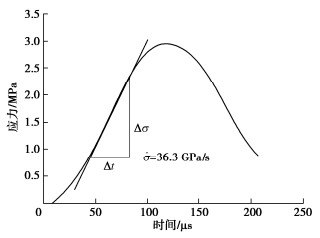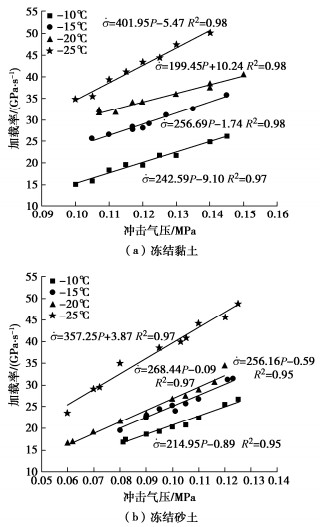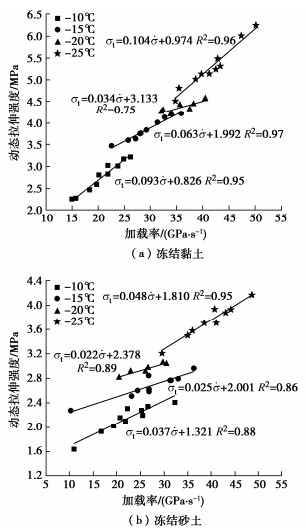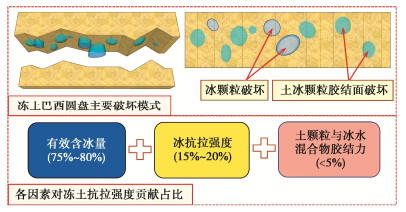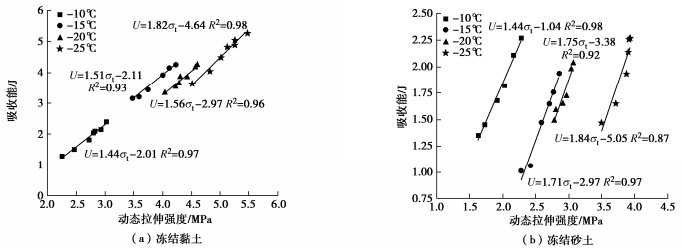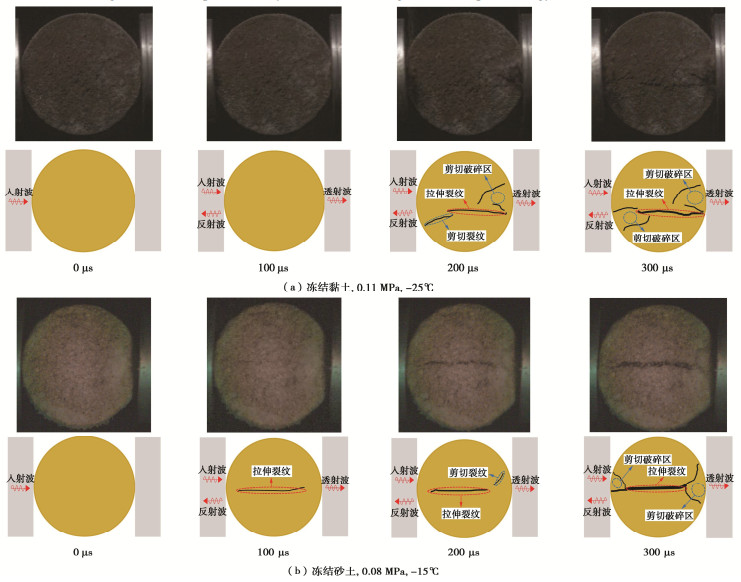Experimental study on splitting tensile failure characteristics of frozen soils under impact loads
-
摘要: 冻土的动态拉伸强度和破坏特性在涉及冻土工程高效破碎和安全稳定性分析领域具有重要的参考价值。为研究负温和加载率对冻土动态拉伸性能的影响,利用铝质分离式Hopkinson压杆试验系统开展了冻土的动态巴西圆盘劈裂试验,结合高速摄像系统,分析了温度和加载率对冻土动态拉伸强度、能量耗散和破坏模式的影响,探讨了冻土巴西圆盘的劈裂破坏机理及动态拉伸强度的影响因素。结果表明:冲击荷载作用下,冻结黏土和冻结砂土巴西圆盘试样均遵循中心起裂的破坏模式,试件破坏为沿轴向相对完整的两半;随着冲击气压的增加,两种冻土的加载率均呈线性增大;两种冻土达到动态拉伸峰值应力所需的时间在92~242 μs范围内;两种冻土的动态拉伸强度均存在明显的温度效应和加载率效应,动态拉伸强度随温度的降低和加载率的增加而增大;不同负温条件下两种冻土的吸收能与动态拉伸强度均存在较好的线性关系;冲击气压的增加会导致冻土试样的破坏程度加剧,高剪切应力引起的三角破碎区面积逐渐增大。Abstract: The dynamic tensile strength and failure characteristics of frozen soils have important reference value in the field of efficient crushing and safety stability analysis of frozen soil projects. To study the effects of negative temperature and loading rate on the dynamic tensile properties of the frozen soils, the aluminum split Hopkinson pressure bar system is employed to conduct the dynamic Brazilian disc splitting test of frozen soil. In addition, by using the high-speed camera system, the influences of temperature and loading rate on the dynamic tensile strength, energy dissipation and failure mode of the frozen soils are analyzed. Finally, the splitting failure mechanism of the Brazilian disc and the influencing factors of dynamic tensile strength of the frozen soils are discussed. The results indicate that under the dynamic loads, the Brazilian disc specimens of frozen clay and frozen sand follow the central initiation failure mode, and the specimens are split into two relatively intact halves along the axial direction. With the increase of the impact pressure, the loading rate of two frozen soil types increases linearly, and the duration required for reaching the dynamic tensile peak stress for them is in the range of 92~242 μs. The dynamic tensile strength of the frozen soils shows the obvious temperature effects and loading rate effects, and its values increase with the decrease of the temperature and the increase of the loading rate. There is a good linear relationship between the absorbed energy and the dynamic tensile strength of the frozen soils under various negative temperature conditions. With the increase of the impact pressure, the damage degree of the frozen soil specimens is aggravated, and the triangular fracture zone area caused by high shear stress gradually increases.
-
Keywords:
- frozen soil /
- dynamic tensile strength /
- negative temperature /
- loading rate /
- failure mode
-
0. 引言
各向异性是黏土的基本性质之一,分为原生各向异性和次生各向异性。针对原生各向异性对黏土力学性状的影响,许多学者对与沉积平面呈不同夹角试样进行压缩、无侧限压缩和三轴压缩等试验,发现原生各向异性对黏土变形以及强度特性的影响不容忽视。
小应变剪切模量特性作为土的重要力学性质之一,也同样受到原生各向异性的影响。Simpson等[1]的研究表明,小应变剪切模量的原生各向异性对隧道及基坑周围土体变形的预测结果影响很大;Jovičić等[2]和吴宏伟等[3]分别针对伦敦黏土和上海软黏土进行研究,利用弯曲元测得两种土在低围压下水平和竖直方向上的最大剪切模量比值分别为1.5和1.21,说明对于不同种类黏土,原生各向异性对其小应变剪切模量的影响不尽相同。
结构性黏土在我国东南沿海地区分布广泛,许多工程建设涉及到此类黏土,迄今已对其小应变剪切模量进行了诸多研究,但以往的研究主要考虑孔隙比、应力水平和结构损伤等对小应变剪切模量的影响[4],而考虑原生各向异性对小应变剪切模量影响的研究较少,有必要进行系统探究。
本文对不同削样方向的湛江黏土原状试样开展不同围压下的共振柱试验,研究原生各向异性对最大动剪切模量的影响以及考虑原生各向异性的最大动剪切模量随围压演化规律的表征方法。
1. 试验材料与试验方案
1.1 试验材料与试样制备
土样取自湛江市某基坑内地下10~11 m,尺寸为30 cm×30 cm×30 cm原状块状样。表1为其基本物理力学指标与颗粒组成。由表1可见,湛江黏土具有较差物理性质,与软黏土相似,但力学性质较优,呈现上述特性的原因为其具有的强结构性[4]。
表 1 湛江黏土平均物理力学性质指标与颗粒组成Table 1. Physical and mechanical indexes and particle composition of Zhanjiang clay重度γ/(kN·m-3) 含水率w/% 孔隙比e 渗透系数K/(cm·s-1) 液限wL/% 塑限wP/% 塑性指数IP 结构屈服应力σk/kPa 无侧限抗压强度/kPa 灵敏度St 颗粒组成/% >0.05/mm 0.005~0.05/mm 0.002~0.005/mm <0.002/mm 17.1 52.98 1.44 2.73×10−8 59.6 28.1 31.5 400 143.5 7.2 8.2 39.5 20.7 31.6 图1(a)为不同方向圆柱试样示意图,定义试样轴线与土体沉积平面夹角为
α ,即竖直方向试样为90°,水平方向试样为0°。针对α 为0°,22.5°,45°,67.5°,90°方向原状样进行研究,试样规格尺寸为直径50 mm,高度100 mm的圆柱体。1.2 试验方法
试验所用设备为GDS共振柱仪,如图1(b)所示。试样的边界条件为一端固定,一端自由。通过电磁驱动系统对试样逐级施加扭矩,测得试样的共振频率和对应的剪应变,试样动剪切模量由下式得到:
G=ρ(2πfH/β)2, (1) 式中,G为试样动剪切模量,ρ为试样密度,f为共振频率,H为试样高度,β为扭转振动频率方程特征值。
试样在抽气饱和后安装至共振柱仪上,随后进行反压饱和,当B值达0.98后,进行固结,围压分别设定为50,100,200,300,400,500,600,700,800 kPa。试样固结完成后,进行共振柱试验。
2. 试验结果与分析
2.1 不同方向试样G-
γ 曲线规律如图2所示,不同方向试样动剪切模量G和剪应变
γ 的关系曲线形态与规律类似。剪切模量在小剪应变下衰减速度较小;随剪应变发展,衰减速度增大。低围压下G-γ 曲线随围压增大而上移,围压超过600~700 kPa,G-γ 曲线随围压增长而下移,与通常软黏土G-γ 曲线大多随围压增大而单调上移规律存在明显差异,说明结构性对湛江黏土G-γ 曲线规律影响较大。2.2 原生各向异性对最大动剪切模量的影响
湛江黏土动应力-应变关系可用Hardin-Drnevich双曲线模型表征,如下式:
τ=γa+bγ, (2) 式中,a,b为拟合参数。式(2)可以写为
1/G=a+bγ。 (3) 式(3)中,当
γ 趋近于0时,得到最大动剪切模量Gmax=1/a,利用式(3)求得不同方向试样在各围压下的Gmax。为了消除孔隙比对Gmax的影响,引入孔隙比函数F(e)=1/(0.3+0.7e2)将Gmax进行归一化处理,图3为经孔隙比函数归一化的Gmax/F(e)-围压σ3 曲线。随围压增大,不同方向试样Gmax/F(e)-σ3 曲线均呈现先上升后下降的规律,在围压为400~500 kPa即在σk 左右时,曲线出现转折。为了更好描述原生各向异性对最大动剪切模量的影响,定义Gmax/F(e)的原生各向异性系数:
Kα=Dα/D90°, (4) 式中,Dα定义为α方向试样的Gmax/F(e),D90°定义为90°(竖直)方向试样的Gmax/F(e)。
Gmax/F(e)的原生各向异性系数Kα与围压的关系如图4所示。相同围压下,Kα随方向角
α 变化,Kα整体上随α 增大而减小,即试样的方向越靠近水平其刚度越大,说明原生各向异性对湛江黏土最大动剪切模量Gmax的影响十分显著。湛江黏土基本单元为扁平状片堆、粒状碎屑矿物与单片颗粒,上述基本单元在沉积时,其长轴更倾向于水平方向,导致颗粒间水平方向的接触更紧密,结构更强[3],进而更靠近水平方向试样的刚度更大。当围压低于400~600 kPa时,同一方向试样Kα随围压增长基本保持恒定,K0°,K22.5°,K45°,K67.5°,K90°分别为1.314,1.279,1.148,1.045,1;当围压高于400~600 kPa时,同一方向试样Kα随围压增长呈明显减小趋势,不同方向试样的Gmax/F(e)差异减小。说明围压低于
σk 时,围压的增大几乎不影响原生各向异性对Gmax的影响,但当围压超过σk 后,围压的增大减弱了原生各向异性对Gmax的影响。文献[2]中伦敦黏土在围压超过屈服应力后,其水平与竖直方向试样的最大剪切模量的差异随围压增长也呈减小趋势,与本文试验结果一致。2.3 考虑原生各向异性的最大动剪切模量表征方法
图3中出现Gmax/F(e)随围压增大呈先上升后下降的特殊现象,文献[4]认为Gmax同时受到平均有效应力、孔隙比和结构损伤的影响,采用该文的表征方法对试验结果进行分析,具体的表达形式如下所示:
Gmax/F(e)=A(1+(σ′mpa)n)1+B(1+(σ′mpa)n)(kr+1−kr1+(ησ′mpc)λ)。 (5) 式中 A,B,n,kr,η和
λ 为反映各种应力历史和土体性质的参数;σ′m 为围压;pa为标准大气压;pc为表观前期固结压力即结构屈服应力σk ,不同方向试样压缩试验得到的σk 差异较小,均取400 kPa。采用式(5)将不同方向试样Gmax/F(e)与围压的关系进行定量表征。从图4可得,高应力下各向异性对试样的Gmax/F(e)影响减弱,可假定不同方向试样Gmax/F(e)极限值相同。最终将试验数据与拟合曲线一同绘制于图5,发现拟合效果很好,拟合参数见表2。
表 2 不同方向试样拟合参数Table 2. Fitting parameters of specimens in different directionsα A/MPa B n kr η λ R2 0° 39.92489 0.16678 0.54309 0.35092 0.56433 6.42998 0.99251 22.5° 37.89951 0.15999 0.58264 0.35462 0.56426 6.37147 0.99075 45° 33.76328 0.15168 0.54642 0.37740 0.55402 6.38473 0.99432 67.5° 31.15476 0.15761 0.56254 0.42499 0.60889 6.07737 0.99727 90° 29.75422 0.15743 0.56067 0.44448 0.57750 6.05669 0.99835 分析表2中拟合参数与试样方向的关系,可得参数A,kr,
λ 和试样轴线与土体沉积平面夹角α 呈线性关系(图6),参数B,n,η随α 增大分别保持在0.1587,0.5591,0.5738上下,且波动范围较小(参数B,n,η的标准差S分别为0.005455,0.01570和0.02131)。将图6中参数A,kr,
λ 的拟合方程和参数B,n,η的平均值同时代入式(5),得到考虑原生各向异性的最大动剪切模量的表征方法:Gmax/F(e)=(c1α+c2)(1+(σ′mpa)n)1+B(1+(σ′mpa)n)· ((d1α+d2)+1−(d1α+d2)1+(ησ′mpc)(e1α+e2))。 (6) 式中
σ′m 为围压;α 表示试样的方向,为试样轴线与土体沉积平面夹角;pa为标准大气压,取101.325 kPa;pc为σk ,取400 kPa;B=0.1587,n=0.5591,η=0.5738;c1=−0.1204,c2=39.9166;d1=1.144×10−3,d2=0.3390;e1=−4.625×10−3,e2=6.4722。3. 结论
(1)在同一围压下,不同
α 试样经孔隙比函数归一化的最大动剪切模量Gmax/F(e)与90°方向试样Gmax/F(e)的比值Kα随α 增大而减小。当围压低于和高于σk 时,同一α 试样Kα随围压增长分别呈基本保持恒定与明显减小趋势,说明当围压低于σk 时,围压几乎不影响原生各向异性对Gmax影响,围压超过σk 后,不同方向的Gmax/F(e)差异减小,围压的增大减弱了原生各向异性对Gmax的影响。(2)受固结压硬和结构损伤的影响,湛江黏土的Gmax/F(e)变化规律与通常软黏土试验结果不同,不同方向试样的Gmax/F(e)随围压增大均呈先增大后减小规律,当围压在
σk 左右时出现转折。(3)基于采用考虑结构损伤的公式可很好拟合湛江黏土不同方向试样Gmax与围压关系曲线,提出了考虑原生各向异性影响的Gmax演化规律表征方法。
-
表 1 黏土颗粒级配
Table 1 Grain-size distribution of clay
粒径/mm 0~0.075 0.075~0.45 0.45~1 1~1.6 1.6~2 百分比/% 51.33 19.72 12.02 11.48 5.45 表 2 砂土颗粒级配
Table 2 Grain-size distribution of sand
粒径/mm 0~0.075 0.075~0.45 0.45~1 1~1.6 1.6~2 百分比/% 0.8 32.29 49.54 13.23 4.14 表 3 冻土试样劈裂破坏模式
Table 3 Splitting failure modes of frozen soil specimens
土质类型 温度/℃ 冲击气压/MPa 0.10 0.11 0.12 0.13 冻结黏土 -15 



冻结砂土 -10 



-
[1] 薛翊国, 孔凡猛, 杨为民, 等. 川藏铁路沿线主要不良地质条件与工程地质问题[J]. 岩石力学与工程学报, 2020, 39(3): 445-468. https://www.cnki.com.cn/Article/CJFDTOTAL-YSLX202003003.htm XUE Yiguo, KONG Fanmeng, YANG Weimin, et al. Main unfavorable geological conditions and engineering geological problems along Sichuan-Tibet railway[J]. Chinese Journal of Rock Mechanics and Engineering, 2020, 39(3): 445-468. (in Chinese) https://www.cnki.com.cn/Article/CJFDTOTAL-YSLX202003003.htm
[2] 胡英国, 吴新霞, 赵根, 等. 严寒条件下岩体开挖爆破振动安全控制特性研究[J]. 岩土工程学报, 2017, 39(11): 2139-2146. doi: 10.11779/CJGE201711023 HU Yingguo, WU Xinxia, ZHAO Gen, et al. Investigation of safety control for rock blasting excavation under cold condition[J]. Chinese Journal of Geotechnical Engineering, 2017, 39(11): 2139-2146. (in Chinese) doi: 10.11779/CJGE201711023
[3] 张熙胤, 于生生, 王万平, 等. 多年冻土区铁路桥梁高承台桩基础地震破坏机理及易损性研究[J]. 土木工程学报, 2022, 55(7): 77-89. https://www.cnki.com.cn/Article/CJFDTOTAL-TMGC202207006.htm ZHANG Xiyin, YU Shengsheng, WANG Wanping, et al. Seismic failure mechanism and fragility of pile foundation with elevated cap of railway bridge in permafrost region[J]. China Civil Engineering Journal, 2022, 55(7): 77-89. (in Chinese) https://www.cnki.com.cn/Article/CJFDTOTAL-TMGC202207006.htm
[4] 马芹永. 人工冻土单轴抗拉、抗压强度的试验研究[J]. 岩土力学, 1996, 17(3): 76-81. https://www.cnki.com.cn/Article/CJFDTOTAL-YTLX603.013.htm MA Qinyong. Tensile strength, uniaxial compressive strength test on artificially frozen soils[J]. Rock and Soil Mechanics, 1996, 17(3): 76-81. (in Chinese) https://www.cnki.com.cn/Article/CJFDTOTAL-YTLX603.013.htm
[5] 彭万巍. 冻结黄土抗拉强度与应变率和温度的关系[J]. 岩土工程学报, 1998, 20(3): 31-33. http://www.cgejournal.com/cn/article/id/10123 PENG Wanwei. Tensile strength of frozen loess varying with strain rate and temperature[J]. Chinese Journal of Geotechnical Engineering, 1998, 20(3): 31-33. (in Chinese) http://www.cgejournal.com/cn/article/id/10123
[6] 陈有亮, 王明, 徐珊, 等. 上海人工冻结软黏土抗压抗拉强度试验研究[J]. 岩土工程学报, 2009, 31(7): 1046-1051. http://www.cgejournal.com/cn/article/id/13311 CHEN Youliang, WANG Ming, XU Shan, et al. Tensile and compressive strength tests on artifical frozen soft clay in Shanghai[J]. Chinese Journal of Geotechnical Engineering, 2009, 31(7): 1046-1051. (in Chinese) http://www.cgejournal.com/cn/article/id/13311
[7] 张勇敢, 鲁洋, 刘斯宏, 等. 基于巴西劈裂试验的冻结膨胀土拉伸特性研究[J]. 岩土工程学报, 2021, 43(11): 2046-2054. doi: 10.11779/CJGE202111011 ZHANG Yonggan, LU Yang, LIU Sihong, et al. Experimental study on tensile strength of frozen expansive soils based on Brazilian splitting tests[J]. Chinese Journal of Geotechnical Engineering, 2021, 43(11): 2046-2054. (in Chinese) doi: 10.11779/CJGE202111011
[8] 马冬冬, 马芹永, 黄坤, 等. 动静组合加载下不同负温人工冻结粉质黏土强度和变形特性分析[J]. 振动与冲击, 2022, 41(1): 154-160. https://www.cnki.com.cn/Article/CJFDTOTAL-ZDCJ202201020.htm MA Dongdong, MA Qinyong, HUANG Kun, et al. Strength of artificially frozen silty clay with different negative temperatures under dynamic and static combined loading and deformation characteristic analysis[J]. Journal of Vibration and Shock, 2022, 41(1): 154-160. (in Chinese) https://www.cnki.com.cn/Article/CJFDTOTAL-ZDCJ202201020.htm
[9] ZHU Z W, JIA J X, ZHANG F L. A damage and elastic-viscoplastic constitutive model of frozen soil under uniaxial impact loading and its numerical implementation[J]. Cold Regions Science and Technology, 2020, 175: 103081.
[10] 赵毅鑫, 肖汉, 黄亚琼. 霍普金森杆冲击加载煤样巴西圆盘劈裂试验研究[J]. 煤炭学报, 2014, 39(2): 286-291. https://www.cnki.com.cn/Article/CJFDTOTAL-MTXB201402012.htm ZHAO Yixin, XIAO Han, HUANG Yaqiong. Dynamic split tensile test of Brazilian disc of coal with split Hopkinson pressure bar loading[J]. Journal of China Coal Society, 2014, 39(2): 286-291. (in Chinese) https://www.cnki.com.cn/Article/CJFDTOTAL-MTXB201402012.htm
[11] 杨仁树, 李炜煜, 李永亮, 等. 3种岩石动态拉伸力学性能试验与对比分析[J]. 煤炭学报, 2020, 45(9): 3107-3118. https://www.cnki.com.cn/Article/CJFDTOTAL-MTXB202009008.htm YANG Renshu, LI Weiyu, LI Yongliang, et al. Comparative analysis on dynamic tensile mechanical properties of three kinds of rocks[J]. Journal of China Coal Society, 2020, 45(9): 3107-3118. (in Chinese) https://www.cnki.com.cn/Article/CJFDTOTAL-MTXB202009008.htm
[12] XIA K W, YAO W. Dynamic rock tests using split Hopkinson (Kolsky) bar system–A review[J]. Journal of Rock Mechanics and Geotechnical Engineering, 2015, 7(1): 27-59.
[13] DAI F, XIA K W. Loading rate dependence of tensile strength anisotropy of barre granite[J]. Pure and Applied Geophysics, 2010, 167(11): 1419-1432.
[14] 平琦, 马芹永, 袁璞. 岩石试件SHPB劈裂拉伸试验中能量耗散分析[J]. 采矿与安全工程学报, 2013, 30(3): 401-407. https://www.cnki.com.cn/Article/CJFDTOTAL-KSYL201303017.htm PING Qi, MA Qinyong, YUAN Pu. Energy dissipation analysis of stone specimens in SHPB tensile test[J]. Journal of Mining & Safety Engineering, 2013, 30(3): 401-407. (in Chinese) https://www.cnki.com.cn/Article/CJFDTOTAL-KSYL201303017.htm
[15] PEI P D, DAI F, LIU Y, et al. Dynamic tensile behavior of rocks under static pre-tension using the flattened Brazilian disc method[J]. International Journal of Rock Mechanics and Mining Sciences, 2020, 126: 104208.
[16] ZHOU G Q, HU K, ZHAO X D, et al. Laboratory investigation on tensile strength characteristics of warm frozen soils[J]. Cold Regions Science and Technology, 2015, 13: 81-90.
-
其他相关附件



 下载:
下载:






